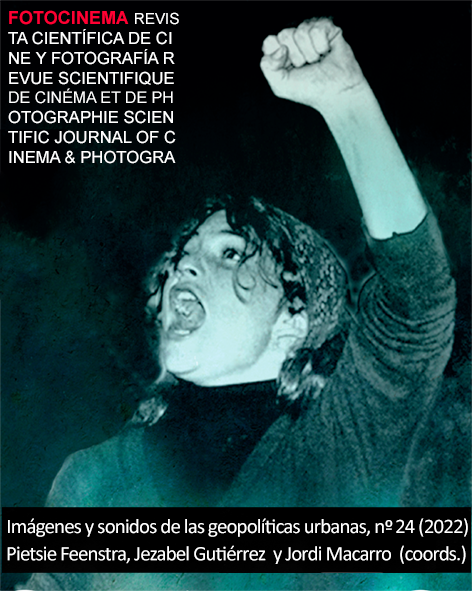Walter Benjamin on photographic melancholy
Keywords:
Melancholy, Photography, Benjamin, Aura, Barthes, TimeAbstract
The goal of this article is to analyse the different meanings of melancholy in photography following Walter Benjamin’s book Kleine Geschichte der Photographie. The main idea that I am going to develop is that, following Benjamin’s text, there are three different ways of understanding melancholy in photography, even if we understand melancholy just as a lost or a missing phenomenon. Firstly, photography is considered by Benjamin as a melancholic phenomenon because it shows a temporal loss: the course of time is unstoppable, even if images try to fasten time. Secondly, Benjamin introduces Barthes later concept of punctum in his book La Chambre Claire: photography would be melancholic because it would be a kind of premonition able to foresee the destiny of its characters. Thirdly, Benjamin shows that not only photography but also the history of photography is melancholic, because its history does not follow the theory of progress but is determined by the loss of aura.
Downloads
Metrics
Publication Facts
Reviewer profiles N/A
Author statements
Indexed in
-
—
- Academic society
- N/A
- Publisher
- Universidad de Málaga
References
Barthes, R. (1986). Lo obvio y lo obtuso. Imágenes, gestos, voces. Barcelona: Paidós.
Barthes, R. (2009). La cámara lúcida, notas sobre la fotografía. Barcelona: Paidós.
Benjamin, W. (1982). Infancia en Berlín hacia 1900, traducción de Klaus Wagner. Madrid: Alfaguara.
Benjamin, W. (2003). La obra de arte en la época de su reproductibilidad técnica, trad. de Andrés E. Weikert, introducción de Bolívar Echevarría. México: Ed. Ítaca.
Benjamin, W. (2009). El narrador. Consideraciones sobre la obra de Nikolái Léskov, en Obras: Libro II/ Volumen 2. Ensayos estéticos y literarios (cont); Fragmentos estéticos; Conferencias y discursos; Artículos de enciclopedia; Artículos de política cultural, traducción de Jorge Navarro Pérez. Madrid: Abada Editores, pp. 41-68.
Benjamin, W. (2011). Breve historia de la fotografía. Madrid: Casimiro.
Benjamin, W. (2013). El libro de los pasajes. Madrid: Akal.
Benjamin, W. (2014). Walter Benjamin. Baudelaire, edición de José Manuel Cuesta Abad, traducción de Alfredo Brtons Muñoz, Jorge Navarro Pérez y Juan Barja. Madrid: Abada Editores.
Castellanos, P. (1999). Diccionario histórico de la fotografía. Madrid: Istmo.
Didi-Huberman, G. (2007). Cuando las imágenes tocan lo real. En G. Didi-Huberman/ C. Chéroux/ J. Arnaldo (ed.), Cuando las imágenes tocan lo real (pp. 9-36). Madrid: Círculo de Bellas Artes.
Didi-Huberman, G. (2009). La imagen superviviente. Historia del arte y tiempo de los fantasmas según Aby Warburg, trad. de Tania Arias y Rafael Jackson. Madrid: Cátedra.
Fletcher, Angus (2002) [1964]. Alegoría. Teoría de un modo simbólico. Madrid: Akal.
Forster, R. y Tatián, D. (2005). Mesianismo, nihilismo y redención. De Abraham a Spinoza. De Marx a Benjamin. Buenos Aires: Altamira.
Gadamer, H. G. (2015). Verdad y método. Salamanca: Sígueme.
González García, J. M. (2012). Los ángeles de Franz Kafka en Walter Benjamin. En J.A. Roche Cárcel (ed.), La sociología como una de las bellas artes. La influencia de la literatura y las artes en el pensamiento sociológico (pp. 79-128). Barcelona: Anthropos.
González García, J. M. (2020). Walter Benjamin: de la diosa Niké al Ángel de la Historia. Ensayos de iconografía política. Madrid: Antonio Machado Libros.
Luelmo Jareño, J. M. (2007). La historia al trasluz. Walter Benjamin y el concepto de imagen dialéctica. Revista Escritura e Imagen, vol. 3, pp. 163-176.
Maikuma, Y. (1985). Der Begriff der Kultur bei Warburg, Nietzsche und Burckhardt. Königstein: Athenäum Verlag.
Mate, Reyes (2006). Medianoche en la historia. Comentarios a las tesis de Walter Benjamin “Sobre el concepto de historia”. Madrid: Trotta.
Mateos de Manuel, V. (2017). El silencio de Salomé. Seis coreografías sobre lo dionisíaco en la modernidad [tesis doctoral]. Madrid: Universidad Complutense de Madrid.
Mateos de Manuel, V. (2019). Estética filosófica y alfabetización fotográfica. Materiales didácticos y experiencia didáctica en Bachillerato. Revista Prisma Social nº 25, pp. 41-65.
Mateos de Manuel, V. (2021). José María González García. Walter Benjamin: de la diosa Niké al Ángel de la Historia. Ensayos de iconografía política [reseña-ensayo]. Revista Arbor. Ciencia, pensamiento y cultura, vol. 197-800, abril-junio 2021, a610. Disponible en: https://arbor.revistas.csic.es/index.php/arbor/article/view/2424/3660
Nerdinger, W./ Barja, J. (Eds.). Walter Benjamin: Eine Reflexion in Bildern. Múnich: Architekturmuseum der TU München/ Círculo de Bellas Artes.
Newhall, B. (2007). Historia de la fotografía. Barcelona: Gustavo Gili.
Price, M. (1994). The Photograph. A Strange Confined Space. Standford: Standford University Press.
Nitsche, J. (2010). Walter Benjamins Gebrauch der Fotografie. Berlin: Kulturverlag Kadmos Berlin.
Rosas Tosas, M. (2015). Mesianismo en la filosofía contemporánea. De Benjamin a Derridá. Barcelona: Herder.
Rosset, C. (2008). Fantasmagorías. Seguido de lo real, lo imaginario y lo ilusorio. Madrid: Abada Editores.
Witte, B. (1990). Walter Benjamin. Una biografía. Barcelona: Gedisa.
Downloads
Published
How to Cite
Issue
Section
License
All contents published in Fotocinema Revista científica de cine y fotografía are protected under the Creative Commons Attribution-NonCommercial-ShareAlike 4.0 International (CC BY-NC-SA 4.0) license. All about this license is available in the following link: <http://creativecommons.org/licenses/by-nc-sa/4.0>
Users can copy, use, redistribute, share and exhibit publicly as long as:
- The original source and authorship of the material are cited (Journal, Publisher and URL of the work).
- It is not used for comercial purposes.
- The existence of the license and its especifications are mentioned.
There are two sets of authors’ rights: moral and property rights. Moral rights are perpetual prerogatives, unrenounceable, not-transferable, unalienable, imprescriptible and inembargable. According to authors’ rights legislation, Fotocinema. Revista científica de cine y fotografía recognizes and respects authors moral rights, as well as the ownership of property rights, which will be transferred to University of Malaga in open access. The property rights are referred to the benefits that are gained by the use or the dissemination of works. Fotocinema. Revista científica de cine y fotografía is published in an open access form and it is exclusively licenced by any means for doing or authorising distribution, dissemination, reproduction, , adaptation, translation or arrangement of works.
Authors are responsable for obtaining the necessary permission to use copyrighted images.










13.png)



